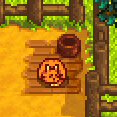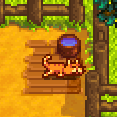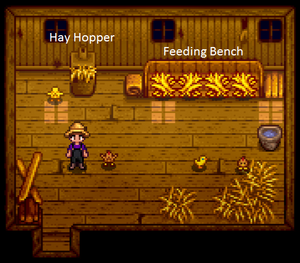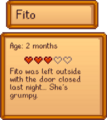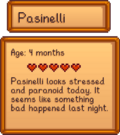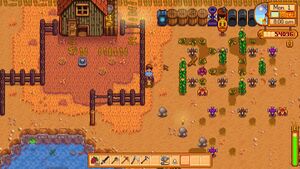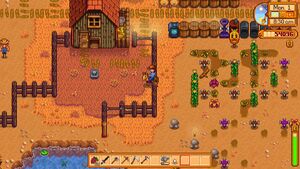Animaux

|
Traduction incomplète Cet article ou cette section n'a pas été complètement traduit en français.
Vous êtes invités à aider à sa traduction en la révisant. |
Les Animaux remplissent plusieurs rôles dans votre ferme. Certains sont sauvages et avec ceux-ci vous ne pouvez pas interagir. Vous pouvez avoir un animal de compagnie, chien ou chat, avec qui vous pouvez développer une amitié. Vous pouvez aussi avoir un cheval que vous pouvez monter. Et bien évidemment, vous pouvez acheter des "animaux de la ferme" qui vous permettront d'obtenir divers productions, des fournitures de ressources ainsi que des bénéfices.
La plupart des Animaux nécessitent un bâtiment pour les loger (pas les animaux de compagnie ou ceux sauvages). Ces constructions peuvent être obtenues auprès de Robine à sa Scierie et requiert en général 3 jours de construction pour chaque bâtiment.
Les bébés "Animaux de la ferme" (ainsi que l'équipement indispensable pour la récolte du produit) peuvent être achetés auprès de Marnie à son Ranch. Les Animaux peuvent être aussi obtenus via un Incubateur. Dès qu'un animal est acquis, il doit être assigné à une construction de ferme déjà existante - comme une Grange ou un Poulailler - qui sera désignée comme sa maison. Chaque bâtiment a un nombre limite d'Animaux pouvant habiter dedans.
Si à n'importe quel moment vous souhaitez assigner un animal à un bâtiment différent, vous pouvez le caresser, et la fenêtre d'information qui apparaît dispose d'un contrôle qui vous permet de procéder à la réaffectation.
Les bébés "Animaux de la ferme" doivent d'abord devenir adulte avant d'être capable de produire des produits d'origine animale. Chaque matin, les Animaux adultes qui vivent dans les poulaillers (poules, canards, lapins et dinosaures) ont une chance de produire des produits qui peuvent être collectés à même le sol de leurs maisons.
En utilisant le Seau de lait, les vaches peuvent en général donner du lait quotidiennement, et les chèvres peuvent en général donner du lait une fois tous les deux jours. Les moutons peuvent être tondus avec les Cisailles lorsque leur laine a assez poussé, et les cochons peuvent être mis dehors afin de déterrer des Truffes que vous pouvez prendre à même le sol.
Chat ou Chien
Le joueur peut adopter un chat ou un chien. L'animal que vous pouvez adopter dépend de votre choix d'animal préféré lors de la création de votre personnage. Vous pouvez choisir entre trois styles de chat et trois styles de chien.
Marnie vous attendra devant votre porte avec un chat ou un chien le premier Mercredi ou Vendredi matin ensoleillé au Printemps après avoir gagné ![]() 1 000po. Vous devez quittez votre maison entre 6:00 et 9:30 pour déclencher cet événement. (Si vous n'avez pas gagné assez d'argent le 20ème jour, l'événement se déclenchera quand même.) Adopter l'animal est optionnel (Marnie vous demandera si vous voulez le garder). Vous pouvez lui donner le nom de votre choix lorsque vous l'adoptez, mais vous ne pourrez pas le changer par la suite (Si vous n'avez pas encore rencontré Marnie quand elle vous apporte l'animal, la rencontre comptera comme une introduction).
1 000po. Vous devez quittez votre maison entre 6:00 et 9:30 pour déclencher cet événement. (Si vous n'avez pas gagné assez d'argent le 20ème jour, l'événement se déclenchera quand même.) Adopter l'animal est optionnel (Marnie vous demandera si vous voulez le garder). Vous pouvez lui donner le nom de votre choix lorsque vous l'adoptez, mais vous ne pourrez pas le changer par la suite (Si vous n'avez pas encore rencontré Marnie quand elle vous apporte l'animal, la rencontre comptera comme une introduction).
Vous pouvez interagir avec votre animal une fois par jour, et il vous montrera son amitié ![]() .
.
Votre animal a une amitié maximale de 1000, augmentant de 12 chaque jour où vous interagissez avec. Tous les 200 points correspondent à 1 niveau, et avoir 800 vous fait gagner 1 point pour l'évaluation de Grand-père.
En atteignant 1000 points d'amitié avec votre animal, le message suivant apparaîtra: " <Nom de l'animal> vous adore ♡" Excepté ce message, il n'y a aucun moyen de voir votre niveau d'amitié avec votre animal dans le jeu.
Il y a u bol sur des planches de bois en haut à gauche de votre maison que vous pouvez remplir d'eau pour votre animal. Si vous lui donnez à boire, le matin suivant l'Amitié de votre animal augmentera de 6 points. (Notez que ceci ne se déclenchera pas s'il pleut le matin suivant.) Les jours de pluie, le bol de votre animal sera rempli automatiquement. S'il pleut avant que vous adoptiez l'animal, le bol restera rempli jusqu'à l'adoption.
Il n'y a pas de mécanisme faisant baisser l'amitié de votre animal. L'ignorer (ou même utiliser le lance-pierre sur votre animal) ne baissera pas l'amitié.
Après avoir gagné 2 cœurs d'Amitié avec le Sorcier, vous pouvez accéder à son sous-sol et changer le style de chat ou de chien au Sanctuaire des Illusions pour ![]() 500po. Vous ne pouvez pas changer de chien à chat ou vice-versa.
500po. Vous ne pouvez pas changer de chien à chat ou vice-versa.
De Dev Blog #29
De Dev Blog #29
Cheval
Le cheval est une monture qui donne un bonus de vitesse de +30%. Il s'obtient en achetant l'Étable dans la Scierie. Comme les autres animaux de compagnie, le cheval peut être nommé quand il est obtenu, mais le champ apparaît seulement la première fois qu'il est chevauché.
Si vous laissez votre cheval quelque part, il vous y attendra, et à votre retour le message suivant apparaît : "<Nom du cheval> se demande où vous étiez." ou "Votre loyal destrier a patiemment attendu votre retour." Si vous allez dormir en laissant votre cheval en dehors de La ferme, votre cheval rentrera automatiquement à la maison et sera dans l'étable le matin suivant.
Le cheval peut passer partout en marchant à l'horizontale, mais à besoin de 2 cases d'espace à la verticale (Sauf sur les ponts où le cheval passe quand même), donc en se promenant à cheval, vous ne pourrez pas passer dans tous les chemins comme si vous étiez à pied. Le cheval ne ralentit pas quand il marche sur les cultures de la ferme.
Les Chapeaux peuvent être posés sur les chevaux. Un chapeau peut être retiré en sélectionnant un autre chapeau dans l'inventaire et en cliquant sur le cheval. (Le chapeau sélectionné reste dans l'inventaire.)
Les soins aux Animaux
Amitié
Les animaux qui vivent dans les granges et les poulaillers ont une barre d'amitié visible en cliquant sur l'animal après l'avoir soigné (en sélectionnant de la paille dans l'inventaire, vous ne pouvez pas ouvrir cette fenêtre ce qui peut être utile si vous l'ouvrez souvent par accident). Le maximum est de 5 cœurs d’amitié, augmente par demi-cœurs, et rentre en compte lorsque le jeu décide de la qualité des produits de l'animal, si celui-ci peut en produire.
Chaque demi-cœur équivaut à 100 points d'amitié, ce qui fait un maximum d’amitié de 1000 points.
Actions qui affectent l'amitié :
- Prendre soin (+15, ou +30 si le joueur à la compétence Éleveur de bétail ou Maître du poulailler et que l'animal est du type correspondant)
- Traire ou tondre(+5, pas de malus si pas de traite ou de tonte)
- Manger de l'herbe à l’extérieur (+8)
- Non nourri (-20 Calculé à la fin de la journée)
- Coincé dehors la nuit (-20 Calculé à la fin de la journée)
- Pas de soin (ne pas parler avec l'animal) (-5 à -10, Calculé à la fin de la journée avec la formule : (10 - (Amitié actuelle / 200))) Les animaux perdront donc moins d’amitié s'ils ont déjà beaucoup d'amitié.
Humeur
Comme l'amitié, l'humeur d'un animal se vérifie en cliquant dessus après en avoir pris soin.
L'humeur est un facteur important pour déterminer la qualité et type de produit qu'il produira. Ceci est seulement pris en compte quand le jeu choisit le produit de l'animal au début de la journée, et n'a pas d'autres effets.
L'humeur est une valeur de 0 à 255. Vous pouvez estimer cette valeur via le message qui apparaît en cliquant dessus :
- <Nom de l'animal> a l'air très heureux aujourd'hui ! indique que l'humeur est de minimum 200 et maximum 255.
- <Nom de l'animal> a l'air d'aller bien. indique que l'humeur est de minimum 30 et maximum 200.
- <Nom de l'animal> a l'air triste. indique que l'humeur est de minimum 0 et maximum 30.
Actions qui affectent l'humeur ("toutes les 10 minutes" correspond à des minutes dans le jeu):
- Prendre soin(+32 à +36 selon le type d'animal, double le total si le joueur a choisi la profession Éleveur de bétail ou Maître du poulailler et que l'animal est du type correspondant)
- Manger de l'herbe à l'extérieur (Met l'humeur à 255)
- C'est l'Hiver et l'animal est dans un bâtiment avec un Radiateur, et a une humeur à 150 ou plus (+4 à +8 toutes les 10 minutes après 18:00, tant que le joueur reste éveillé, jusqu'à 255. Un seul radiateur est requis. Outrepasse les autres effets "toutes les 10 minutes")
- L'animal est nourri (+4 à +16, selon le type d'animal, calculé lorsque le joueur dort, vérifie si l'animal a mangé de la paille ou de l'herbe)
- L'animal est dehors après 18:00, mais avant 19:00, et a au moins 150 d'humeur (+4 à +8 toutes les 10 minutes ne s'ajoute pas aux autre effets "toutes les 10 minutes")
- L'animal est dehors quand il pleut ou en Hiver (-4 à -8 toutes les 10 minutes ne s'ajoute pas aux autre effets "toutes les 10 minutes")
- L'animal est dehors après 19:00 (-4 à -8 toutes les 10 minutes ne s'ajoute pas aux autre effets "toutes les 10 minutes")
- L'animal a dormi dehors (-moitié de l'humeur actuelle, calculé quand le joueur dort)
- Pas de soin (-20 à -40, selon le type d'animal, calculé quand le joueur dort)
- L'animal n'a pas été nourri (-100 calculé quand le joueur dort)
Production
Les nouveaux animaux doivent devenir adultes avant de pouvoir produire quelque chose. Chaque espèce a son propre nombre de jours requis entre chaque production. Par exemple, les vaches et les poules peuvent produire du lait et des œufs tous les jours, et les chèvres produisent du lait tous les 2 jours. Les animaux qui peuvent produire des produits Large ou Deluxe peuvent parfois produire plus fréquemment (voir "Cas spécial" plus bas.)
Si suffisamment de jours ont passé pour sa production, quelques vérifications additionnelles détermineront si l'animal peut effectivement produire.
- Si l'animal n'a pas été nourri, il ne produira pas.
- Si l'animal a moins de 70 points d'humeur, il y a une chance qu'il ne produise pas. Plus basse est l'humeur, moins il a de chances de produire. (le pourcentage de chance qu'il produise quand même est de Humeur/70)
Que l'animal produise un produit Deluxe ou Large, et la qualité du produit, est déterminé au début de la journée, aléatoirement en fonction de l'humeur et l'amitié.
- Si l'animal a 150 d'humeur ou plus, il pourra produire des produits de qualité, ou Deluxe ou Large. (Notez qu'il s'agit seulement de pouvoir les produire, la chance de les produire réellement est expliquée plus bas, des produits de qualité, ou Large ou Deluxe, ne sont pas garantis)
- Si l'animal a moins de 150 d'humeur, il a toujours une chance de produire un produit de qualité, ou Large ou Deluxe. Plus basse est l'humeur, moins il a de chance. (Le pourcentage de chance est de Humeur/150)
Cas spécial: Si l'animal peut produire quelque chose, mais ne peut pas faire de produit de de qualité, ou Large ou Deluxe, le jeu n'enregistrera pas qu'il a produit quelque chose ce jour-ci. Dans ce cas, les animaux qui produisent normalement en plusieurs jours, produiront à nouveau immédiatement le lendemain.
Produits de grande taille et de luxe
A "Mood Modifier" is calculated when rolling for whether Deluxe produce (Large products, Duck Feathers, and Rabbit feet) will be created in the following ways:
- If Mood is more than 200, it will be multiplied by 1.5
- If Mood is 100 or less, then "Mood Modifier" will be the animals mood minus 100 (This will always result in a negative or zero modifier)
- Otherwise "Mood Modifier" is Zero (Mood is higher than 100, and up to 200)
This "Mood Modifier" will be used in different ways depending on the animal.
Try to stay above 200 Mood for a large bonus
Plumes de Canard et Pattes de Lapin
Ducks and rabbits will take into account the Daily Luck to determine if they will create their Deluxe produce.
For each duck or rabbit, an overall score is created using the following formula: (Friendship + Mood Modifier)/5000 + Daily Luck
For example, an animal with 600 Friendship (3 Hearts), 150 Mood, and 0.10 (Max) Daily Luck, would be calculated as:
=(600 + (0))/5000 + 0.10
=(600+0)/5000 + 0.10
=0.22
Each time a product is rolled, a random number between 0-1 is rolled against this score. If the overall score is higher than the random number, a Deluxe product will be created. At max Friendship, Mood, and Luck, you will have a 38% chance of getting a Deluxe product
Gros Oeufs et Grande quantité de lait
For animals to produce a Large product, the game will take Mood and Friendship into account.
Only animals with 200 or higher friendship can produce Large products.
Each animal will have an overall score created with the following formula: (Friendship + Mood Modifier)/1200
For example, an animal with 600 Friendship (3 Hearts) and 210 Mood would be calculated as:
=((600 + (210*1.5))/1200
=(600+315)/1200
=0.7625
Each time a product is rolled, a number between 0-1 is chosen randomly. If the overall score is higher than the random number, a Large product will be created. In our example there is a 76% chance of a large product. An overall score of at least 1200 will guarantee a Large product.
Qualité
If the animal has the ability to produce a Quality item, it will roll for quality from normal to iridium.
Each animal will have an overall score created with the following formula: ((Friendship/1000) - (1 - (Mood/225))
For example, an animal with 600 Friendship (3 Hearts) and 150 Mood would be calculated thus:
=((600/1000) - (1 - (150/225))
=0.6 - (1 - 0.666...)
=0.6 - 0.333...
=0.266...
If the player has the Shepherd or Coopmaster Profession, and the animal is a relevant type, 0.33 will be added to the score.
The game will begin checking what quality to create by first seeing if the score value is above 0.95. If it is, the score divided by 2 will be compared against a random number between 0-1. If the score divided by 2 is greater than the random number, the item will be Iridium quality.
- In our given example, a score of 0.266... is not above 0.95; the item would not be able to become Iridium.
If an Iridium quality item is not produced, the score divided by 2 will be compared against a random number between 0-1. If the score divided by 2 is greater than the random number, the item will be Gold quality.
- In our given example, a score of 0.266... would be divided by 2 to become 0.133...; the item would have a 13% chance to become Gold quality.
If a Gold quality item is not produced, the score will be compared against a random number between 0-1. If it is greater than the random number, the item will be Silver quality.
- In our given example, if the item was not Gold, it would have a 26.6% chance to be Silver quality.
If the item is not Silver quality, it will be Normal quality.
Logement
Buildings can be purchased from the Carpenter's Shop, and will be completed within a few days. Once placed, they can be moved around at the Carpenter's Shop as well.
Barns, Coops and Slime Hutches house animals, Silos store hay, and the Stable unlocks the Horse.
Nourriture
Farm animals who live in barns and coops need to eat every day, one "portion" per animal. They can eat either fresh grass (if allowed outside) or hay (if kept inside or are unable to find grass). They do not die if not fed, but become upset and cease production of animal products until feeding resumes. They do not need to be fed on a festival day. The game automatically considers them fed, even though no hay or grass is consumed.
Newly hatched, born, or purchased animals do not need to be fed on the day they arrive on the farm, but baby animals thereafter need to eat one "portion" (the same as adults) each day. If they don't have food, they do not grow on that day.
Slimes in a Slime Hutch need no food, but their troughs can be filled daily with water from the watering can. If watered, they will produce Slime Balls the next day.
Horses and pets do not need to eat, but pets will be happier once you fill the water bowl each day.
Silos, Trémies, et Bancs d'alimentation
Hay can be purchased from Marnie's Ranch for ![]() 50po per piece. Place the hay in your inventory onto the Feeding Bench in a farm building to make it available as food for your animals.
50po per piece. Place the hay in your inventory onto the Feeding Bench in a farm building to make it available as food for your animals.
To save the expense of buying hay, you must build at least one silo (eventually, it is common to have three or more). Each silo stores up to 240 pieces of hay, and can be filled by using a scythe on grass outside (50% chance of hay from each grass unit cut). If your silos are your storage account for hay, then the Hay Hoppers in the farm buildings are the hay ATMs, where you can withdraw hay into your inventory or deposit it into storage. The hopper will give you the exact amount of hay needed to fill the feeding bench for one day for the building you are in. The Deluxe Coop and Deluxe Barn withdraw and distribute hay to the Feeding Benches automatically.
Should you wish to have fewer silos, you can pull hay from the hopper and store it in chests. To do so you must have a coop or barn that does not have a full feeding bench and then you can pull multiple times from the hopper, provided you do not have the hay equipped. This becomes impossible if all of your coops and/or barns have been completely upgraded to deluxe as the feeding benches are always full thus you cannot withdraw hay from the hopper.
It can be placed in the shipping bin but yields 0g.
In the winter, snow covers the grass completely, making grazing impossible. Therefore, it is advisable to use the scythe to cut some or all of the grass into hay before the end of the fall season to ensure enough reserve hay to feed your animals through the winter. It is generally considered a good practice to build a silo and begin storing hay even before building your first coop or barn.
Hay can also be made into a Grass Skirt when tailored with Cloth at the sewing machine located inside Emily and Haley's house.
Préférences d'alimentation
Farm animals prefer fresh grass to hay, and become "very happy today!" (the best mood) upon eating fresh grass. They will not go out in winter, or when it is rainy, stormy, or snowy. Animals that remain inside or do not find grass to eat, eat hay instead, if it is available.
Animals that do go outside normally return to their buildings by 6pm, to sleep. Closing the gates again in the evening prevents them from leaving immediately in the morning to eat grass, before you have time to pet and tend them the next day. If you close the gate before all the animals have returned, the ones left out over night are vulnerable to wild animal attacks. If they are not eaten, they become unhappy from being exposed to danger.
Animaux piégés à l'extérieur
An animal may be trapped outside a barn or coop if the doors are closed at night. The conditions that cause an animal to be trapped outside are not clear. It may be more likely for an animal to be trapped outside if the player does not leave the farm after 5pm (when animals begin to return to the barn/coop) and does not enter the barn/coop after 5pm. (Leaving the farm and entering the barn/coop after 5pm both seem to cause animals to transport or spawn to the inside of the barn/coop automatically). It may also be more likely to happen if the player goes to bed before 5pm.
If it rains the next day, and the animal was left out, the animal will stay outside in the rain. This is the only instance in which a farm animal will be outside during the rain. Similarly, if an animal is trapped outside on the night of Fall 28, the animal will stay outside on Winter 1.
An animal left outside its barn/coop will be grumpy the next day.
Attaques des animaux sauvages
If an animal has been trapped outside (see previous section) with the barn or coop doors closed, there is a chance they will be attacked by a wild animal during the night.
After the player goes to sleep, any events that will happen during the night (such as Bundle events) are calculated as normal. If no events are due to occur, there will be a 50% chance that the game will attempt to start a wild animal attack event. If this event proceeds, the game will go through all buildings to find a barn or coop that has their doors closed and has animals left outside.
For each building, the game takes a random number between 0 and 1 and compares it to 1/(the number of total farm buildings). If the random number is larger, the building is ignored. In other words, the more buildings the player has, the less likely that one will be attacked. For example, if the player has two farm buildings, each building has a 50% chance of being attacked, three buildings would give 33%, four would give 25% chance of being attacked, etc.
Once a building has been chosen, the event takes the first animal stuck outside from that building to be the target of the attack. The animal will be removed from the game and in the morning, all other animals will have a mood message saying "<animal name> looks stressed and paranoid today. It seems like something bad happened last night."
Anniversaires des animaux
Similar to animal attacks, if there are no other events occurring in the night, there will be a 50% chance that the game will attempt an animal birth event. The game searches through all buildings for an upgraded Barn that isn't full. The game then makes another check where there is a 0.55% * (the number of animals inside) chance of proceeding with the event. For example, an upgraded barn with three animals inside would have a 1.65% chance of passing this check. If the building fails this check, the game will continue going through all buildings until none are left.
If a barn passes all these checks, a random animal inside is chosen. If the animal is not a baby and has pregnancy enabled, that animal will give birth.
Vente des Animaux
To sell a coop or barn animal, right-click the animal after petting. The friendship/mood interface appears. Move the cursor over the gold coin button at the right to see how much you can sell the animal for. Click that button and the confirmation that follows to complete the sale.
Proceeds from the sale of animals do not count as earnings in the game's accounting of total earnings (visible from the pause menu).
Aimaux du Poulailler
These animals cannot be purchased until a Coop is built on your farm, and must occupy a spot in a coop. They will leave their products inside the coop each morning.
Poules
- Article principal: Chicken
Adult chickens will produce eggs every morning if fed. Happier chickens may produce larger, more valuable eggs.
| Image | Name | Cost | Produces | 5 Heart Selling Price |
|---|---|---|---|---|
| Chicken | ||||
| Chicken | ||||
| Chicken | ||||
| Void Chicken | n/a |
To obtain a Void Chicken; in a random event after you sleep, a witch will fly over one of your Chicken Coops, leaving you with a Void Egg in the morning. Alternatively, you can purchase a Void Egg from the Traveling Cart in Cindersap Forest or from Krobus for ![]() 5 000po in The Sewers. After you obtain the Void Egg, putting the egg into an Incubator (you must have the Big Coop) will result in the hatching of a Void Chicken.
5 000po in The Sewers. After you obtain the Void Egg, putting the egg into an Incubator (you must have the Big Coop) will result in the hatching of a Void Chicken.
Whether you receive a white or brown chicken when purchasing from Marnie is random.
After seeing Shane's 8-heart event, each chicken you purchase from Marnie has a 1/4 chance of being blue. Aside from appearance, blue chickens are identical to white chickens.
You may receive a White, Brown, or Blue (If blue has been unlocked) Chicken from incubating an egg of either type (White or Brown).
Canards
- Article principal: Duck
Adult ducks will lay an egg or drop a Duck Feather every other day. Happier ducks have a higher chance to produce Duck Feathers instead of an egg.
| Image | Name | Cost | Requirements | Produces | 5 Heart Selling Price |
|---|---|---|---|---|---|
| Duck | Big Coop |
Lapins
- Article principal: Rabbit
| Image | Name | Cost | Requirements | Produces | 5 Heart Selling Price |
|---|---|---|---|---|---|
| Rabbit | Deluxe Coop |
Once sufficient friendship is reached, they can produce Rabbit's Foot automatically just like wool.
Dinosaures
- Article principal: Dinosaur
To obtain a Dinosaur, a Dinosaur Egg must be found while Artifact hunting, and then placed in an Incubator. In approximately 12.5 days, a Dinosaur will hatch.
The Dinosaur acts like any other coop animal, but it lays Dinosaur Eggs every 7 days and makes no sound.
| Image | Name | Cost | Requirements | Produces | 5 Heart Selling Price |
|---|---|---|---|---|---|
| Dinosaur | n/a | Big Coop |
Animaux de la Grange
These animals cannot be purchased until a Barn is built on your farm, and must occupy a spot in a barn. Their products are either gathered with a tool, or in the case of pigs, left on the ground outside while grazing.
Barn animals may become pregnant at random if the pregnancy option is enabled on their status menu. This is opened by interacting with the animal after having done so to give it affection first. An icon to the right of the menu can be toggled to allow pregnancy for that animal. If an animal becomes pregnant, during the night a message box will pop up saying an animal gave birth. The game will then prompt you to choose a name for the new animal. For pregnancy to happen you need to have upgraded to a Big Barn and have enough room for another animal.
Vaches
- Article principal: Cow
| Image | Name | Cost | Produces | 5 Heart Selling Price |
|---|---|---|---|---|

|
Cow |
|
||

|
Cow |
|
Chèvres
- Article principal: Goat
| Image | Name | Cost | Requirements | Produces | 5 Heart Selling Price |
|---|---|---|---|---|---|

|
Goat | Big Barn |
Goats produce milk every other day.
Moutons
- Article principal: Sheep
| Image | Name | Cost | Requirements | Produces | 5 Heart Selling Price |
|---|---|---|---|---|---|

|
Sheep | Deluxe Barn |
Sheep need to be shorn when their coat grows in. Shears can be purchased at Marnie's Ranch.
A sheep will normally grow in its coat every 3rd day if it has been fed and has at least 70 happiness.
If the player has 900 or more Friendship with the sheep and has pet it at least one time, it will reduce it to every other day.
If the player also has Shepherd, it will reduce the time required to regrow by a further day, making a sheep grow its coat every single day.
Cochons
- Article principal: Pig
| Image | Name | Cost | Requirements | Produces | 5 Heart Selling Price |
|---|---|---|---|---|---|

|
Pig | Deluxe Barn |
Pigs will find Truffles after being let outdoors. Truffles can be used in the Oil Maker to make Truffle Oil.
Collection will be affected by Foraging skill, allowing you to gather iridium quality Truffles with a chance of double harvest.
During Winter, pigs will not produce Truffles since the field is covered in snow and they won't leave the barn.
Clapier à Slimes
- Article principal: Slime Hutch
Although technically not an animal, Slimes can reside on the farm similar to other animals. Slimes are unique in that they are not docile and harmless like other animals. They are similar in appearance and behavior to Slimes found elsewhere in the game, and will attack and damage the player if able to. They are obtained by placing a Slime Egg in a Slime Incubator, either a player-crafted one or the built-in one that comes with the Slime Hutch.
Slimes produce ![]() Slime Balls, and do so only when both male and female Slimes are present in the same location, and when given access to water via the troughs in the Slime Hutch. The Slime Ball can be right-clicked to release multiple
Slime Balls, and do so only when both male and female Slimes are present in the same location, and when given access to water via the troughs in the Slime Hutch. The Slime Ball can be right-clicked to release multiple ![]() Slime items. These piles of slime have a chance of appearing daily, much like the products of coop animals.
Slime items. These piles of slime have a chance of appearing daily, much like the products of coop animals.
Male and female slimes will also occasionally breed with each other. The color of the resulting offspring will fall anywhere on a spectrum between the parents' colors (e.g., a green slime may breed with a red slime to produce a yellow or orange slime).
Slime Eggs can be obtained as rare drops from Slimes or by compressing 100 Slime items in a Slime Egg-Press. They come in various colors and will produce slimes of the same color as the egg. Slimes of any color can breed with slimes of any other color.
Slimes incubated or bred in this way can be fought and killed just like any other slimes, and will drop items. A slime hutch can become a very dangerous place after even a few eggs have hatched, and it is advised that players take caution. It is recommended that the player obtain the Slime Charmer Ring before attempting large-scale slime farming.
It is also important to note that once the hutch has more than 5 Slimes, there is a 3.5% chance per night per slime to escape and disappear.
In a random event after going to sleep, a Witch will fly over the Slime Hutch, turning all of the Slimes into Black Slimes.
Autres Animaux
On ne peut pas interagir avec nombres d'animaux tels que : les lapins (sauvages), les écureuils, les grenouilles, les corbeaux,les Piverts, les moineaux (petits oiseaux bruns) ainsi que les papillons, le serpent de mer, etc. Les écureuils peuvent occasionnellement faire tomber au sol des Noisettes ou d'autres graines d'Arbres.
Papillons
Les Papillons sont abondants, de diverses couleurs, même s'ils ne peuvent être vus que pendant l'Été et le Printemps. Afin de voir des Papillons, il faut secouer ou couper des Arbres.
Corbeaux
Chaque nuit, il y a une chance que les Corbeaux mangent vos Récoltes[1] à votre Ferme. Les Corbeaux ne voudront pas manger des récoltes provenant de graines sauvages mais les graines en elles-même (ex, celles plantées le jour même) ou des cultures à la portée de un ou plusieurs Épouvantails.
Pour 16 cultures (arrondi vers le bas), un Corbeau essayera d'en manger une, pour un maximum de 4 corbeaux.
Chaque culture a 30% de chance de se faire manger. Un Corbeau cherchant à manger une culture essayera 10 fois d'en trouver une admissible. Un corbeau choisit au hasard un carreau labouré dans la ferme. (Note: Ceci est fait après que certains sols labourés de la ferme redeviennent non labourés[2]) Si ce carreau contient une culture qui a poussé au-delà des semences, le corbeau arrêtera d'en chercher. Si la culture est à la portée d'un Épouvantail, le corbeau sera effrayé. Sinon, le Corbeau mangera la culture. Notez que les Corbeaux pourront aussi manger les cultures mortes de la saison précédente.
Un Corbeau mangera une unique culture mais pourra rester aux alentours et picorer le sol. Cette animation est purement cosmétique.

Lucioles
Les lucioles peuvent être vues partout, pendant la nuit mais en particulier dans la Forêt Sève-Cendreuse pendant l'été. Elles créent une petite lueur lumineuse autour d'elles.
Hiboux
Les Hiboux sont assez peu communs et ne peuvent être vus que pendant la nuit (19:00h-2:00h). Ils sont observables durant n'importe quelle Saison.
Mouettes
On peut les apercevoir à La plage. Elles peuvent flotter dans la mer, ne faisant rien, ou en train de se "laver" avec leurs becs. Lorsque Le joueur s'approche de trop elles s'envoleront. Anecdote : au vu de la couleur du bec (ici jaune), ces oiseaux marins seraient plutôt des Goélands que des Mouettes.
Bugs
- You can easily glitch through one-tile-wide objects (like fences, sprinklers, or scarecrows) while riding the horse. Just ride vertically alongside the object, then turn 90° into the object.
- Placing the horse behind the ice-cream stand when nobody is there lets you buy ice-cream.
Références
Historique
- 1.3 : Fixed bug causing animal happiness to decrease if the player stayed up after 6pm. Added ability to place hats on horses.
- 1.4 : Added 2 new styles of cat and 2 new styles of dog. Made pet style changeable at Shrine of Illusions. Added ability to remove hats from horses. Removed exploit allowing wallpaper #108 to be used in an incubator in place of a Dinosaur Egg. Rain now fills the pet bowl.
| Animaux et produits | |
|---|---|
| Poulailler | Canard (Oeuf de canard • Plume de canard) • Dinosaure (Oeuf de dinosaure) • Lapin (Laine • Patte de lapin) • Poulet (Oeuf • Gros oeuf • Oeuf brun • Gros oeuf brun) • Poulet doré (Oeuf en or) • Poulet vide (Oeuf du Vide) |
| Grange | Chèvre (Lait de chèvre • Grand lait de chèvre) • Cochon (Truffe) • Mouton (Laine) • Vache (Lait • Grosse quantité de lait) • Autruche (Oeuf d'autruche) |
| Étang à poissons | Poisson (Oeufs de poisson) |
| Clapier pour Slime | Slimes (Boule de Slimes • Oeuf de Slime • Slime) |
| Autres | Chat • Cheval • Chien |
